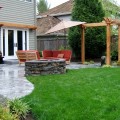Landscape Phasing
Are you a homeowner on a budget? Do you have a big property with several big projects on your wish list? Are you bumfuzzled as to where to start on putting together a coherent landscape plan? If so, landscape phasing may be the answer to your question.
As the name implies, landscape phasing develops your landscape design over time using incremental steps. The involved, expensive undertakings are spaced out in a way that makes sense from a project management point of view.
This kind of long-term planning provides several benefits. The primary one is financial: you spread your big outlay of cash over several months or even years.
To be completely fair, it must be pointed out that the overall cost usually totals more under the phased-in approach. The additional expense is explained by the need to tear things up and then put them back in place. Again and again. However, some homeowners prefer the relatively small additional expense to taking on one big lump sum at one time.
A simple example of a phased-in plan is one designed just for softscapes, the plant materials. For example, in the first phase, you concentrate on the plantings around the house. In the second phase, you may design the beds and garden structures you want along the back fence. The third step might be specialty plantings, such as a rose garden.
For more involved landscapes, logic is the key word. It needs to drive the implementation plan. Most experts usually recommend starting with the infrastructure. This list includes hardscapes items, such as drainage systems, driveways and retaining walls.
In subsequent steps, layers are added. Perhaps it means installing a flagstone patio or putting in an irrigation system. Or maybe you want an outdoor kitchen, an outdoor water fountain or a garden arbor. The last step, or top “layer”, usually means applying the finishing touches to the lawn and garden beds.
An example of a four-year landscape phasing plan might look like this:
Phase 1: Design and install a drainage system. Plant trees. Design and install preliminary landscape lighting.
Phase 2: Plan and install an irrigation system. Design and build a custom swimming pool.
Phase 3: Build specially designed wrought iron fence and gates.
Phase 4: Create pathways. Finalize landscape lighting. Fill in empty spots in landscape with appropriate plant material.
Trees deserve special attention when using the landscape phasing approach. Trees are both valuable and expensive. Therefore, many pros suggest that homeowners plant trees in the first phase.
The reasoning goes: if you plant, for example, a seven-foot tree with a five-foot spread in the first year, you could have 16-foot tree with a 12-foot spread in four years. Planting smaller trees early in the process has a positive impact on your budget. For proof: go to your local tree nursery and check out the difference between the price of a 30-gallon tree and a 300-gallon tree.
A side benefit occurs when trees grow and mature within your landscape. You will get a better sense of what needs to go around them at their more mature size.

